trailer TOYOTA YARIS 2011 3.G Owners Manual
[x] Cancel search | Manufacturer: TOYOTA, Model Year: 2011, Model line: YARIS, Model: TOYOTA YARIS 2011 3.GPages: 416, PDF Size: 10.18 MB
Page 3 of 416

1
2
3
4
5
6
7
3
2-5. Driving informationCargo and luggage ............. 165
Vehicle load limits ............... 168
Winter driving tips ............... 169
Trailer towing (except Canada) ............... 172
Trailer towing (Canada) ...... 173
Dinghy towing (vehicles with an automatic
transmission) .................... 181
Dinghy towing (vehicles with a manual
transmission) .................... 182
3-1.
Using the air conditioning
system a
nd defogger
Air conditioning system ....... 186
Rear window and outside rear view mirror
defoggers .......................... 193
3-2. Using the audio system Audio system type............... 195
Using the radio .................... 197
Using the CD player ............ 203
Playing back MP3 and WMA discs ........................ 208
Optimal use of the audio system .............................. 215
Using the AUX port ............. 217
3-3. Using the interior lights Interior lights list .................. 218
• Interior light ....................... 219
• Personal lights .................. 219 3-4. Using the storage features
List of storage features ....... 220
• Glove boxes ..................... 221
• Cup holders ...................... 222
• Bottle holders ................... 223
• Auxiliary boxes ................. 225
3-5. Other interior features Sun visors........................... 227
Vanity mirrors ..................... 228
Clock .................................. 229
Power outlet ....................... 231
Floor mat ............................ 232
Luggage compartment features ............................ 234
4-1. Maintenance and care Cleaning and protecting the vehicle exterior ........... 238
Cleaning and protecting the vehicle interior ............ 241
4-2. Maintenance Maintenance requirements .................... 244
General maintenance ......... 246
Emission inspection and maintenance (I/M)
programs .......................... 249
3Interior features
4Maintenance and care
Page 119 of 416
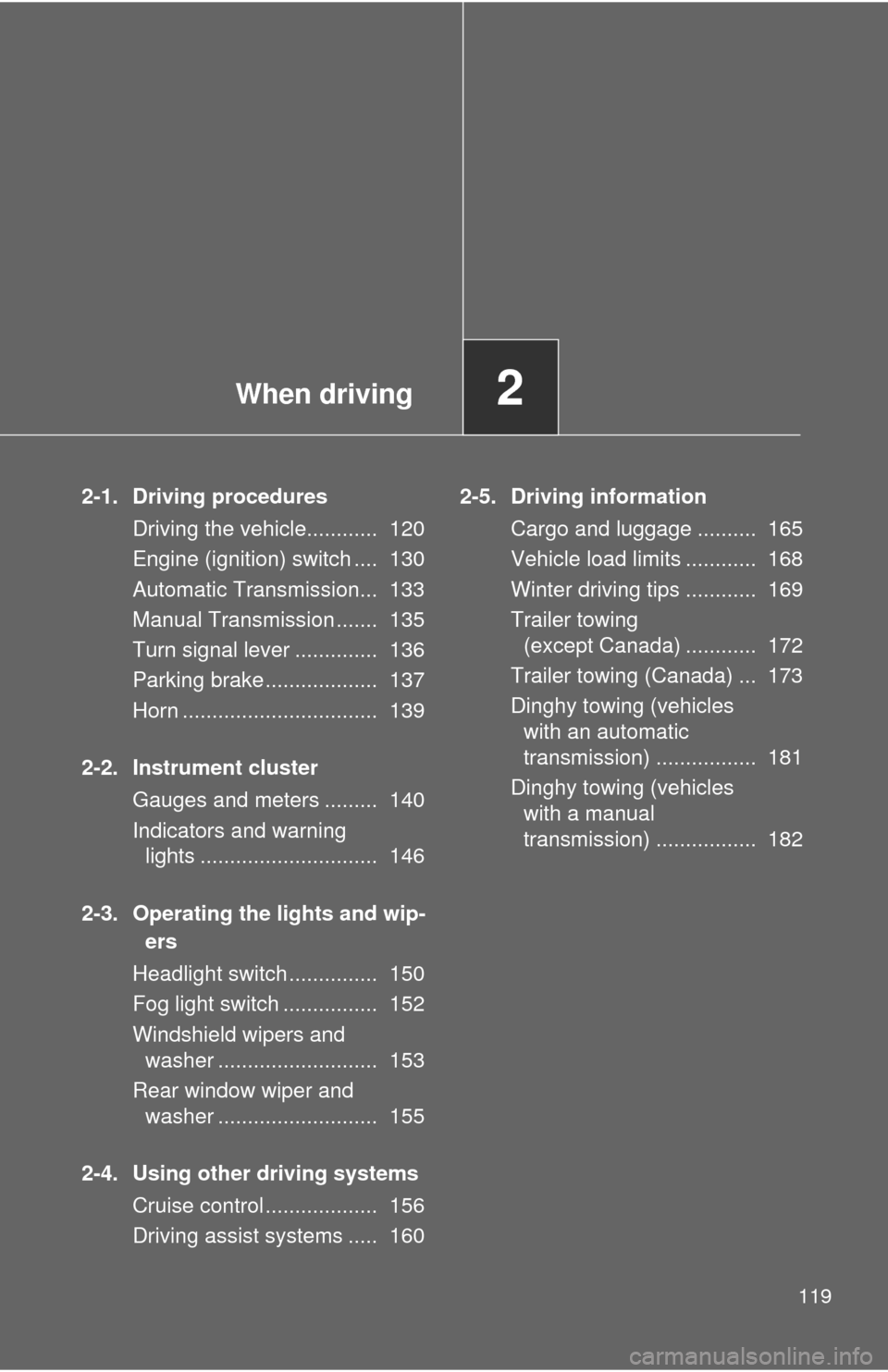
When driving2
119
2-1. Driving proceduresDriving the vehicle............ 120
Engine (ignition) switch .... 130
Automatic Transmission... 133
Manual Transmission ....... 135
Turn signal lever .............. 136
Parking brake ................... 137
Horn ................................. 139
2-2. Instrument cluster Gauges and meters ......... 140
Indicators and warning lights .............................. 146
2-3. Operating the lights and wip- ers
Headlight switch ............... 150
Fog light switch ................ 152
Windshield wipers and washer ........................... 153
Rear window wiper and washer ........................... 155
2-4. Using other driving systems Cruise control ................... 156
Driving assist systems ..... 160 2-5. Driving information
Cargo and luggage .......... 165
Vehicle load limits ............ 168
Winter driving tips ............ 169
Trailer towing (except Canada) ............ 172
Trailer towing (Canada) ... 173
Dinghy towing (vehicles with an automatic
transmission) ................. 181
Dinghy towing (vehicles with a manual
transmission) ................. 182
Page 122 of 416
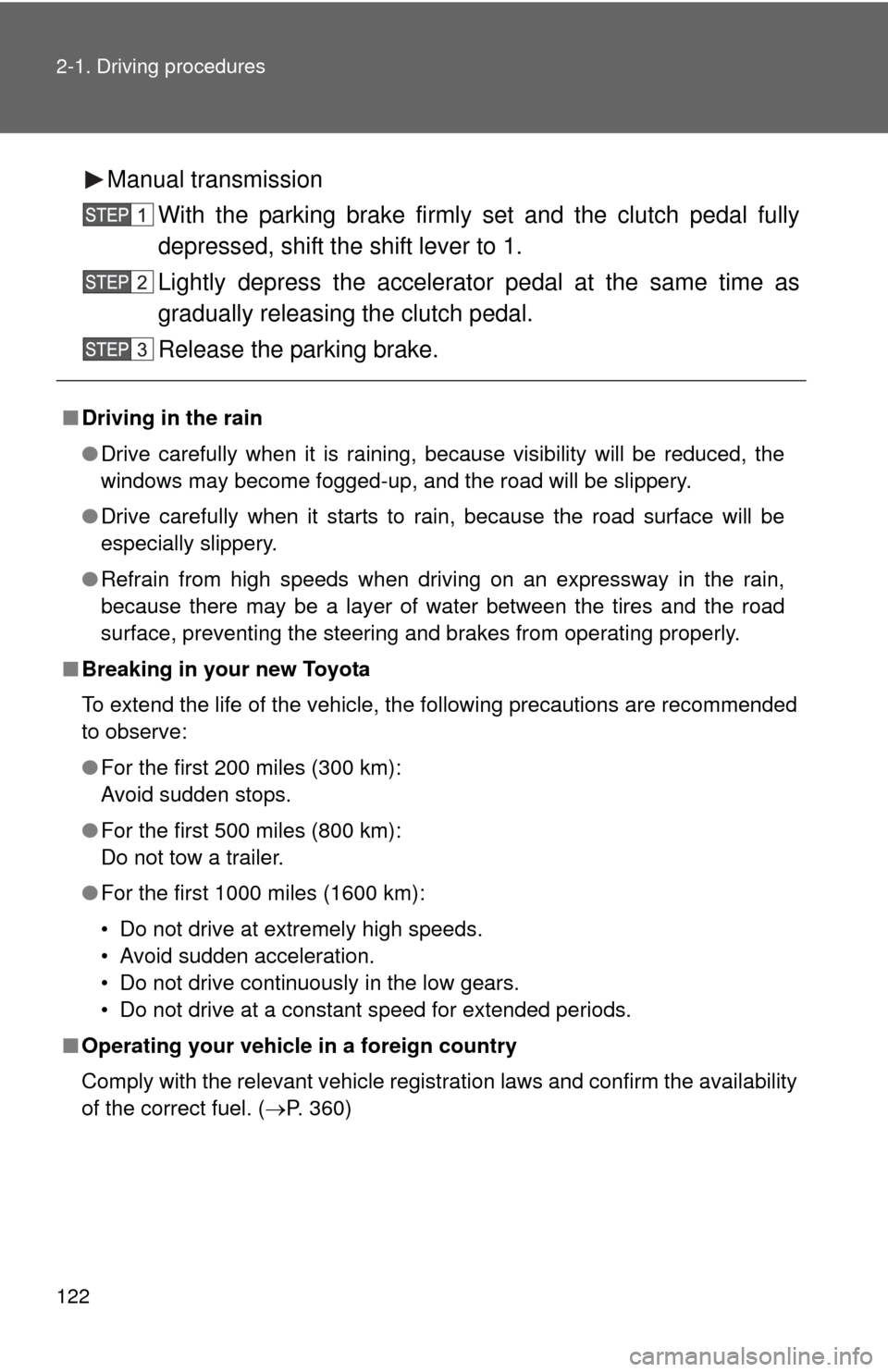
122 2-1. Driving procedures
Manual transmissionWith the parking brake firmly set and the clutch pedal fully
depressed, shift the shift lever to 1.
Lightly depress the accelerator pedal at the same time as
gradually releasing the clutch pedal.
Release the parking brake.
■Driving in the rain
●Drive carefully when it is raining, because visibility will be reduced, the
windows may become fogged-up, and the road will be slippery.
● Drive carefully when it starts to rain, because the road surface will be
especially slippery.
● Refrain from high speeds when driving on an expressway in the rain,
because there may be a layer of water between the tires and the road
surface, preventing the steering and brakes from operating properly.
■ Breaking in your new Toyota
To extend the life of the vehicle, the following precautions are recommended
to observe:
●For the first 200 miles (300 km):
Avoid sudden stops.
● For the first 500 miles (800 km):
Do not tow a trailer.
● For the first 1000 miles (1600 km):
• Do not drive at extremely high speeds.
• Avoid sudden acceleration.
• Do not drive continuously in the low gears.
• Do not drive at a constant speed for extended periods.
■ Operating your vehicle in a foreign country
Comply with the relevant vehicle registration laws and confirm the availability
of the correct fuel. ( P. 360)
Page 159 of 416
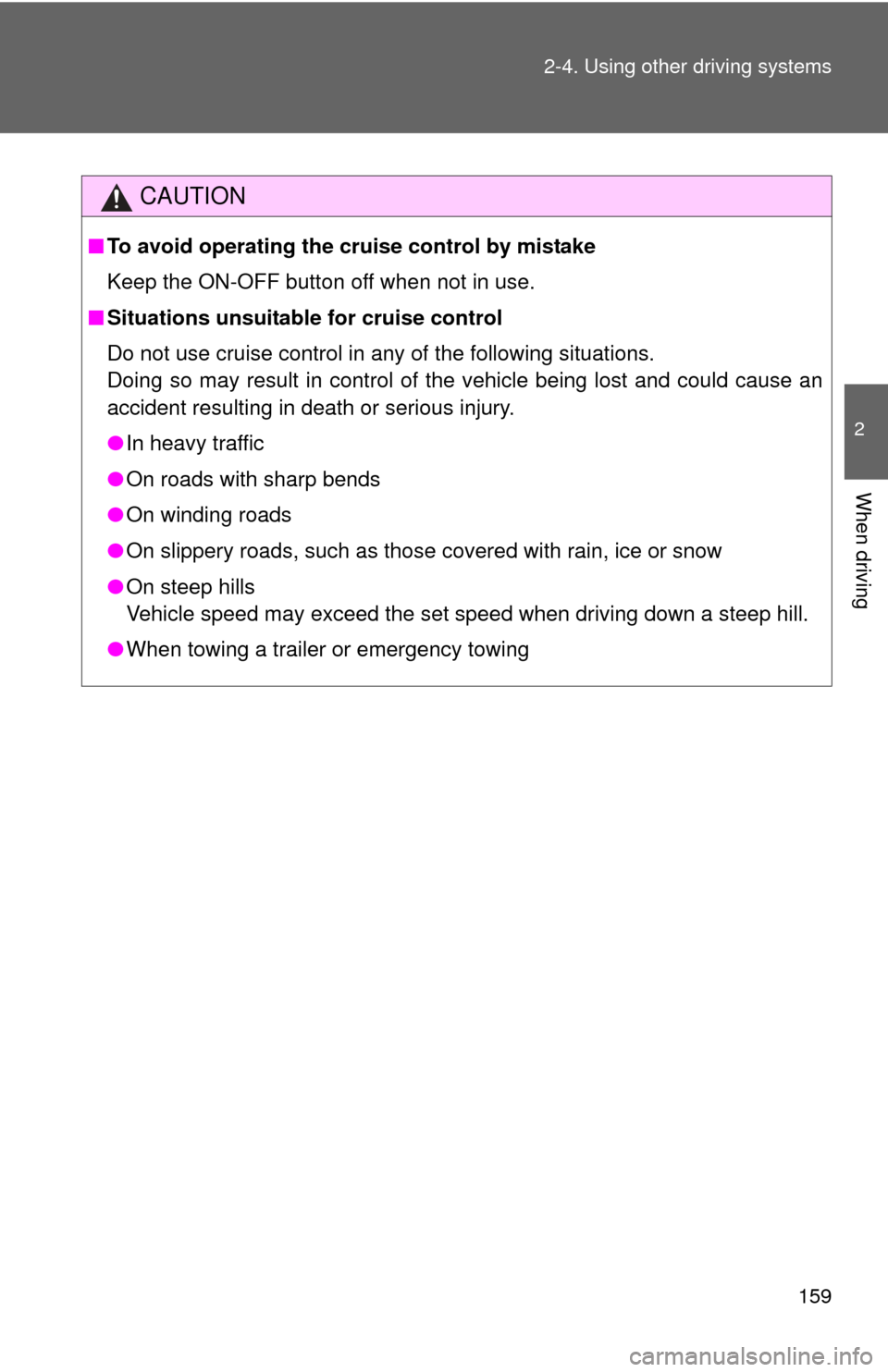
159
2-4. Using other
driving systems
2
When driving
CAUTION
■To avoid operating the cruise control by mistake
Keep the ON-OFF button off when not in use.
■ Situations unsuitable for cruise control
Do not use cruise control in any of the following situations.
Doing so may result in control of the vehicle being lost and could cause an
accident resulting in death or serious injury.
●In heavy traffic
● On roads with sharp bends
● On winding roads
● On slippery roads, such as those covered with rain, ice or snow
● On steep hills
Vehicle speed may exceed the set speed when driving down a steep hill.
● When towing a trailer or emergency towing
Page 166 of 416
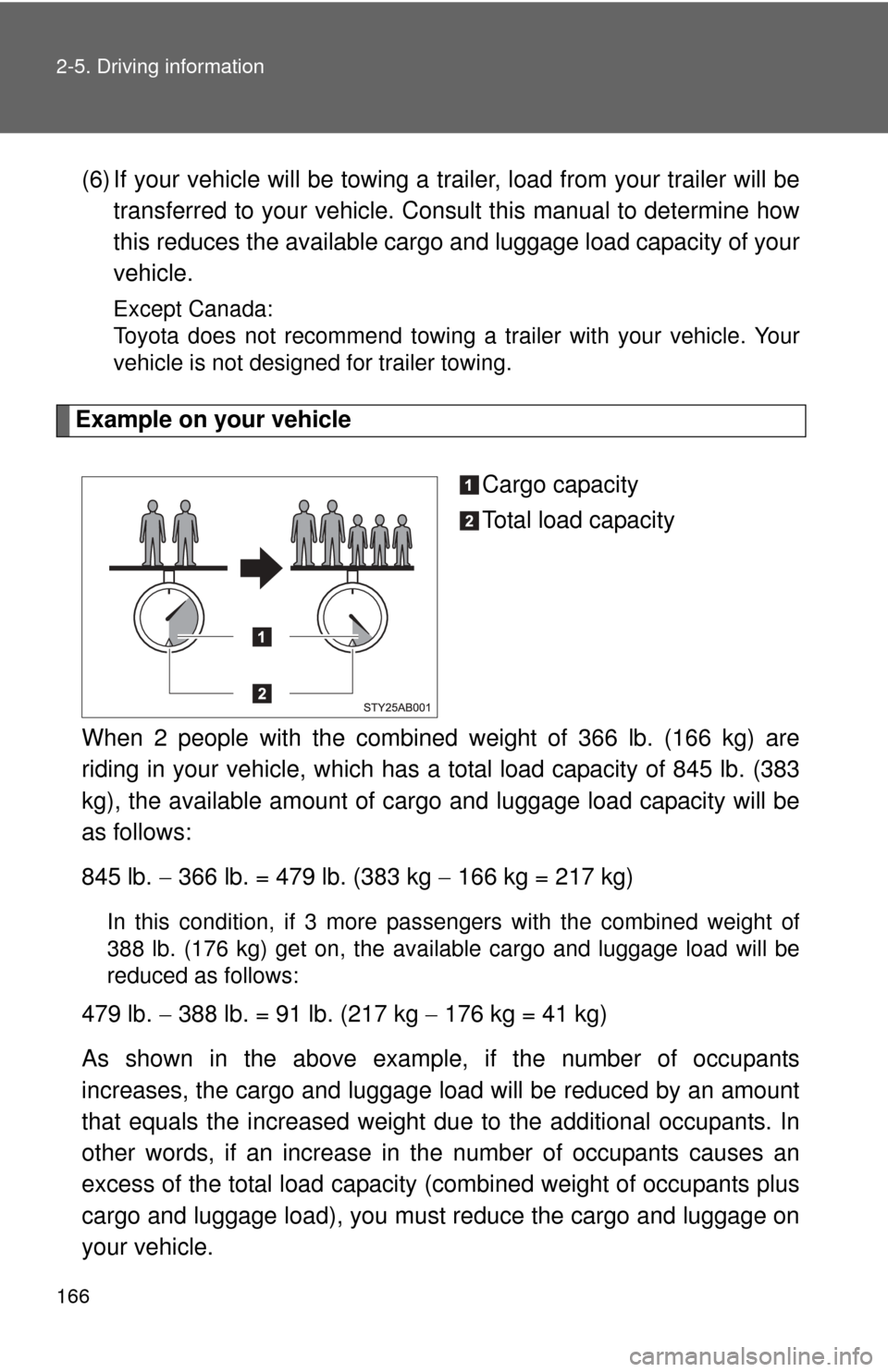
166 2-5. Driving information
(6) If your vehicle will be towing a trailer, load from your trailer will be
transferred to your vehicle. Consult this manual to determine how
this reduces the available cargo and luggage load capacity of your
vehicle.
Except Canada:
Toyota does not recommend towing a trailer with your vehicle. Your
vehicle is not designed for trailer towing.
Example on your vehicle
Cargo capacity
Total load capacity
When 2 people with the combined weight of 366 lb. (166 kg) are
riding in your vehicle, which has a total load capacity of 845 lb. (383
kg), the available amount of cargo and luggage load capacity will be
as follows:
845 lb. 366 lb. = 479 lb. (383 kg 166 kg = 217 kg)
In this condition, if 3 more pa ssengers with the combined weight of
388 lb. (176 kg) get on , the available cargo and luggage load will be
reduced as follows:
479 lb. 388 lb. = 91 lb. (217 kg 176 kg = 41 kg)
As shown in the above example, if the number of occupants
increases, the cargo and luggage load will be reduced by an amount
that equals the increased weight du e to the additional occupants. In
other words, if an increase in the number of occupants causes an
excess of the total load capacity (combined weight of occupants plus
cargo and luggage load), you must reduce the cargo and luggage on
your vehicle.
Page 168 of 416
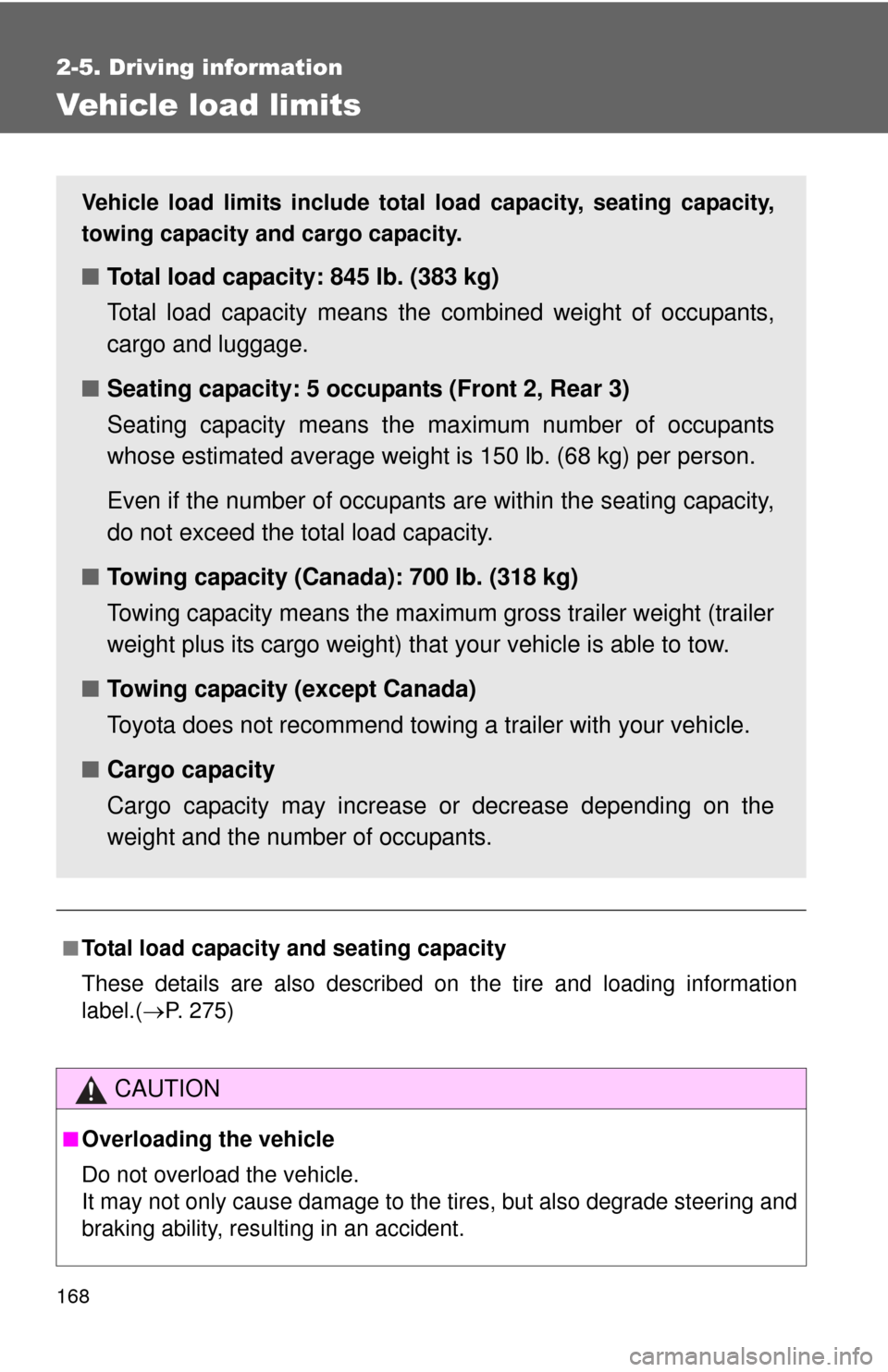
168
2-5. Driving information
Vehicle load limits
■Total load capacity and seating capacity
These details are also described on the tire and loading information
label.(P. 275)
CAUTION
■Overloading the vehicle
Do not overload the vehicle.
It may not only cause damage to the ti res, but also degrade steering and
braking ability, resulting in an accident.
Vehicle load limits include total load capacity, seating capacity,
towing capacity and cargo capacity.
■ Total load capacity: 845 lb. (383 kg)
Total load capacity means the combined weight of occupants,
cargo and luggage.
■ Seating capacity: 5 occupants (Front 2, Rear 3)
Seating capacity means the ma ximum number of occupants
whose estimated average weight is 150 lb. (68 kg) per person.
Even if the number of occupants are within the seating capacity,
do not exceed the total load capacity.
■ Towing capacity (Canada): 700 lb. (318 kg)
Towing capacity means the maximum gross trailer weight (trailer
weight plus its cargo weight) that your vehicle is able to tow.
■ Towing capacity (except Canada)
Toyota does not recommend towing a trailer with your vehicle.
■ Cargo capacity
Cargo capacity may increase or decrease depending on the
weight and the number of occupants.
Page 172 of 416
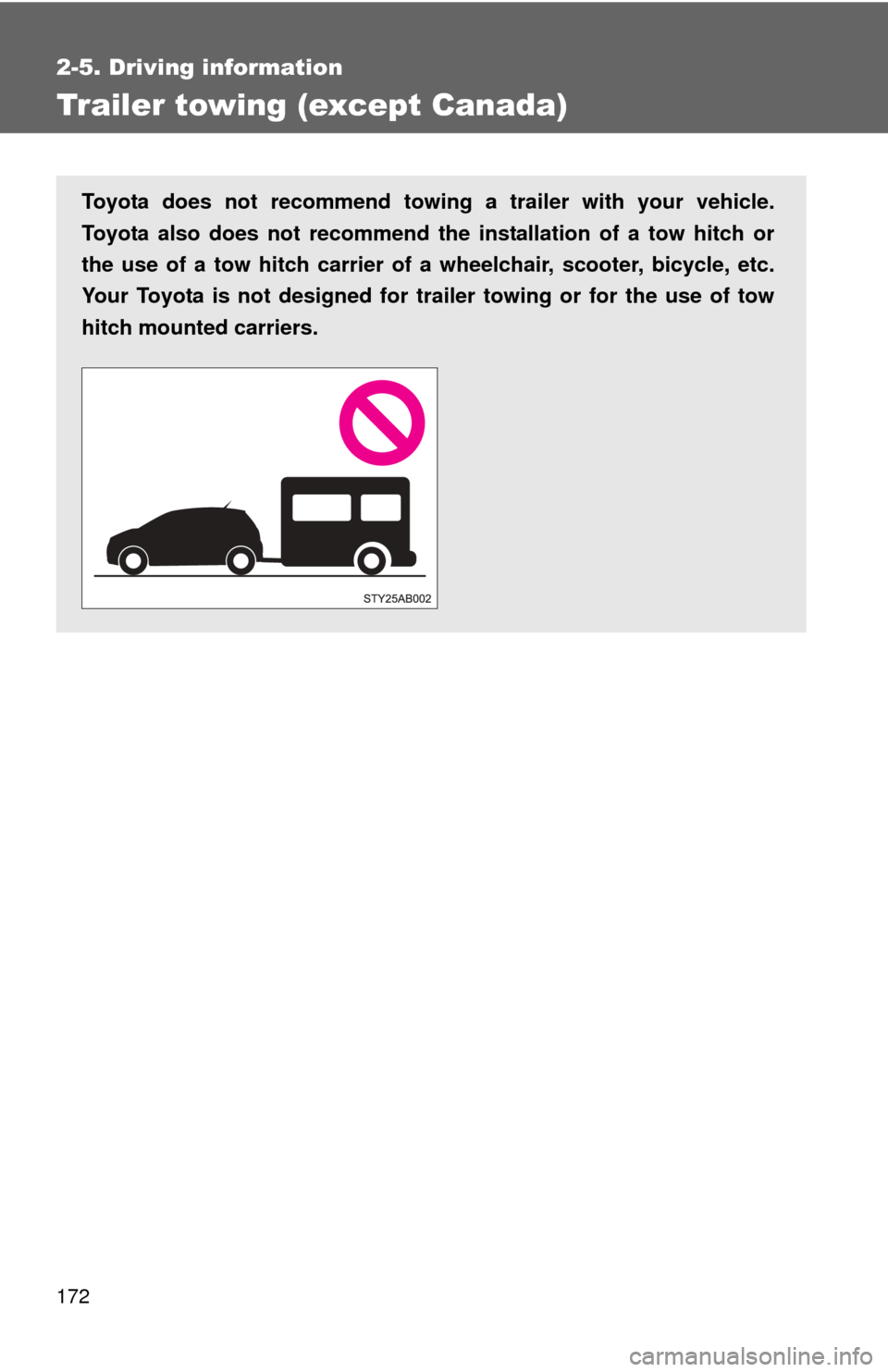
172
2-5. Driving information
Trailer towing (except Canada)
Toyota does not recommend towing a trailer with your vehicle.
Toyota also does not recommend the installation of a tow hitch or
the use of a tow hitch carrier of a wheelchair, scooter, bicycle, etc.
Your Toyota is not designed for tr ailer towing or for the use of tow
hitch mounted carriers.
Page 173 of 416
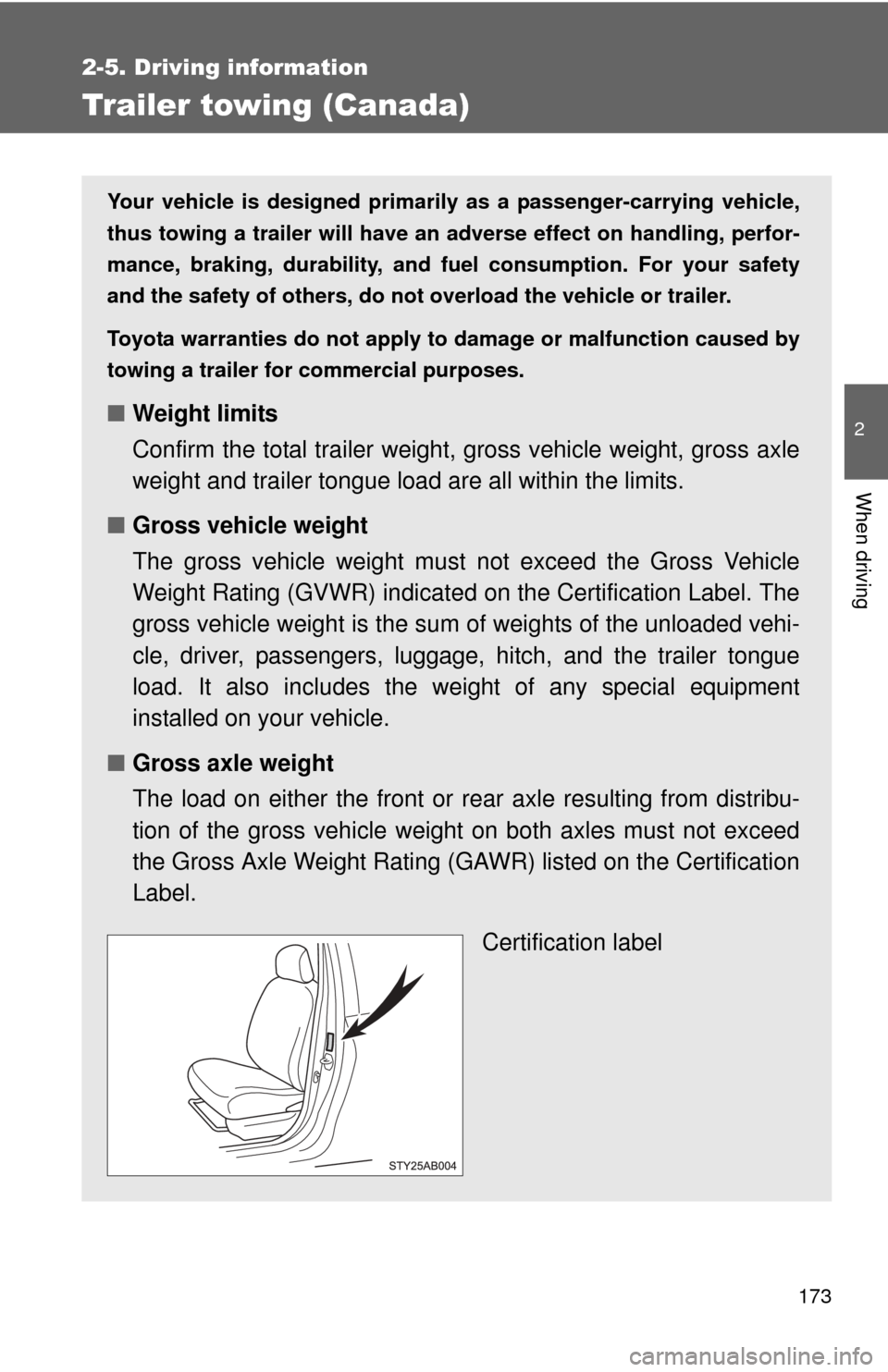
173
2-5. Driving information
2
When driving
Trailer towing (Canada)
Your vehicle is designed primarily as a passenger-carrying vehicle,
thus towing a trailer will have an ad verse effect on handling, perfor-
mance, braking, durability, and fu el consumption. For your safety
and the safety of others , do not overload the vehicle or trailer.
Toyota warranties do not apply to damage or malfunction caused by
towing a trailer for commercial purposes.
■ Weight limits
Confirm the total trailer weight, gross vehicle weight, gross axle
weight and trailer tongue load are all within the limits.
■ Gross vehicle weight
The gross vehicle weight must not exceed the Gross Vehicle
Weight Rating (GVWR) indicated on the Certification Label. The
gross vehicle weight is the sum of weights of the unloaded vehi-
cle, driver, passengers, luggage, hitch, and the trailer tongue
load. It also includes the we ight of any special equipment
installed on your vehicle.
■ Gross axle weight
The load on either the front or rear axle resulting from distribu-
tion of the gross vehicle weight on both axles must not exceed
the Gross Axle Weight Rating (GAWR) listed on the Certification
Label.
Certification label
Page 174 of 416
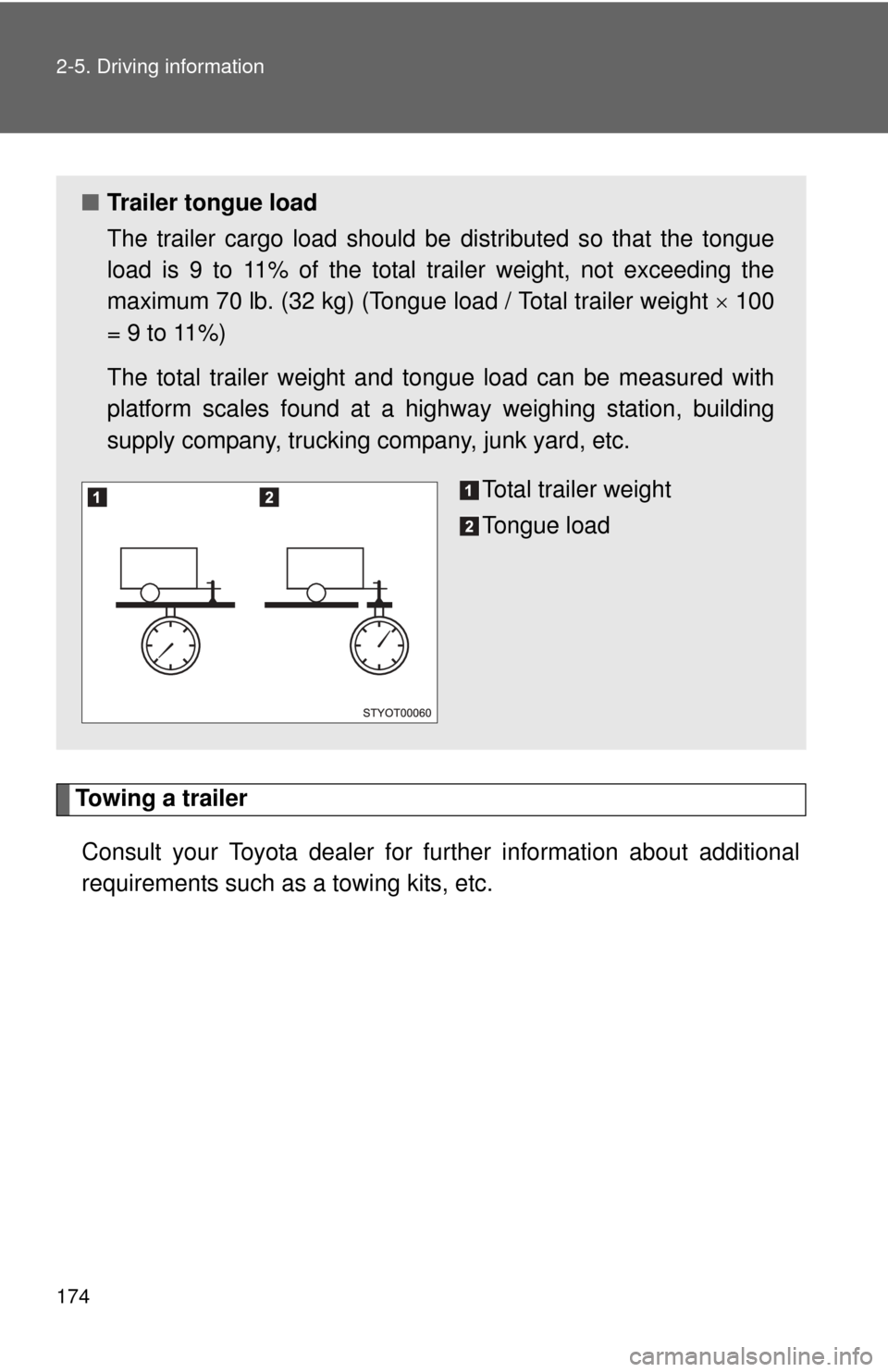
174 2-5. Driving information
Towing a trailerConsult your Toyota dealer for further information about additional
requirements such as a towing kits, etc.
■ Trailer tongue load
The trailer cargo load should be distributed so that the tongue
load is 9 to 11% of the total trailer weight, not exceeding the
maximum 70 lb. (32 kg) (Tongue load / Total trailer weight 100
= 9 to 11%)
The total trailer weight and tongue load can be measured with
platform scales found at a highway weighing station, building
supply company, trucking company, junk yard, etc.
Total trailer weight
Tongue load
Page 175 of 416

175
2-5. Driving information
2
When driving
■
Before towing
Check that the following conditions are met:
●Ensure that your vehicle’s tires are properly inflated. ( P. 365)
● Trailer tires should be inflated according to the trailer manufacturer’s rec-
ommendation.
● All trailer lights work to be legal.
● Confirm all lights work each time you connect them.
● The trailer ball is set up at the proper height for the coupler on the t\
railer.
● Check that your vehicle remains level when a loaded or unloaded trailer
is hitched. Do not drive if the vehicle is not level, and check for improper
tongue load, overloading, worn suspension, or other possible causes.
● Make sure the trailer cargo is securely loaded.
● Check that your rear view mirrors c onform to any federal, state/provincial
or local regulations. If they do not, inst all rear view mirrors appropriate for
towing purposes.
■ Break-in schedule
●Toyota recommends that you do not use a new vehicle or a vehicle with
any new power train components (engine, transmission, differential,
wheel bearings, etc.) to tow a trailer for the first 500 miles (800 km) of
driving.
■ Maintenance
●If you tow a trailer, your vehicle will require more frequent maintenance
due to the additional load. (See “Scheduled Maintenance Guide” or
“Owner’s Manual Supplement”.)
● Retighten the fixing bolts of the towing ball and bracket after approxi-
mately 600 miles (1000 km).